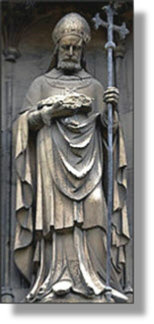


LANFRANC c1010 -
xxxxxIt was during his long stay at the monastery of Bec in Normandy (1042 to 1066) that the Italian-
 xxxxxWilliam I came to the English throne with the support of the Pope. In 1070 he deposed the Anglo-
xxxxxWilliam I came to the English throne with the support of the Pope. In 1070 he deposed the Anglo-
xxxxxLanfranc was born in Pavia, and, having studied law and philosophy, he went to Tours to study theology and then taught this subject at his own school in Avranches. He entered the monastery of Bec, Normandy, in 1042. Here he quickly gained a reputation as a theologian and church reformer, and the school he established at the monastery was soon attracting scholars from all over Europe. He became the Head of Caen Abbey in 1066 and, four years later, William -
 xxxxxUnder his leadership the English church was given a much firmer direction. English clergy were replaced by Normans, special ecclesiastical courts were set up, and the clergy were forbidden to marry. During his period of office many new churches were built and work was begun on the rebuilding of Canterbury Cathedral (illustrated). And in the struggle that was beginning between the rights and powers of the Pope in the affairs of State, he gave strong support to William in his refusal to allow the Pope, the formidable Gregory VII, to exercise any real authority over the English church.
xxxxxUnder his leadership the English church was given a much firmer direction. English clergy were replaced by Normans, special ecclesiastical courts were set up, and the clergy were forbidden to marry. During his period of office many new churches were built and work was begun on the rebuilding of Canterbury Cathedral (illustrated). And in the struggle that was beginning between the rights and powers of the Pope in the affairs of State, he gave strong support to William in his refusal to allow the Pope, the formidable Gregory VII, to exercise any real authority over the English church.
xxxxxIn scholarship, he is chiefly remembered for his Book on the Body and Blood of the Lord, a learned treatise on the subject of the church's eucharistic doctrine.
xxxxxHe died two years after the death of the King he had served so well, and was succeeded in 1093 (W2) by one of his outstanding pupils, Anselm. He was to serve both William II and Henry I but, as we shall see, unlike Lanfranc, his relationship with his monarchs was far from harmonious.
W1-
Acknowledgements
Lanfranc: from a statue at Canterbury Cathedral, artist unknown. Cathedral: by courtesy of Dr Thomson’s Tours, Canterbury, Kent, England, UK.


